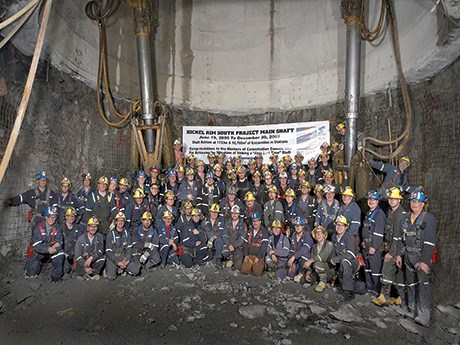North Bay company celebrates 20th anniversary
Cementation Canada Inc., one of the country’s premier mining contractors, is celebrating its 20th anniversary this year.
Cementation had a foothold in Canada through the ’70s when it built a number of potash shafts in Saskatchewan, but left the country in the early ’80s. In 1998, the company, which was owned at the time by Scandinavia’s Kvaerner Group, decided to get back into the contracting business in Canada and asked a much younger Roy Slack, current president of Cementation Canada, to evaluate potential acquisitions.
In the end though, recalled Slack, “instead of buying a company, they asked me if I would start one for them.”
A mining engineer and graduate of Queen’s University in Kingston, Ontario, Slack had extensive experience in the mining contracting business, having worked for both Redpath in North Bay and Bharti Laamanen Mining in Sudbury.
“We were very successful,” recalled Slack. “Right from the start we had a core of really good people. Our first big job was the Kidd Number 4 shaft in Timmins, which we took on as a design-build project. We were awarded the engineering in 2000 and the construction of the shaft – a winz – in 2001.”
Descending to 3,014 metres, it’s the deepest shaft in the world outside of South Africa.
Still based in North Bay with offices in Sudbury, Rouyn-Noranda and Vancouver, the company has tackled dozens of challenging projects in Canada and the United States over the years, eventually spinning off a U.S.-based subsidiary after winning major contracts at Resolution Copper in Arizona and Hecla Mining’s Lucky Friday operation in Idaho.
“We did something a little different,” recalled Slack. “Most contracting groups would set up a branch office. We didn’t do that. In 2008, we set up a full service office in Salt Lake City with engineering, estimating and payroll because we thought that was important to building up our market in the U.S.”
Cementation constructed the Number 10 shaft at Resolution, the deepest single lift shaft in the U.S. at 6,943 feet, and is currently rehabilitating the Number 9 shaft.
Kvaerner sold Cementation to Skanska in 2001 and Skanska sold the company to Murray and Roberts in South Africa in 2004, but it was business as usual for the Canadian-based group.
Slack attributes Cementation Canada’s success in part to its focus on innovation – technological and otherwise.
“For example, mining contractors weren’t offering a design-build solution, so right from the start we built a very strong engineering team to offer that service. For us, so much of technology is focused on keeping our people safe. As a mining contractor, we can’t bring in revolutionary technologies without the client being on board. It’s their mine and their money, so the innovation in contracting is very much a collaborative effort with our clients.”
Slack is particularly proud of the partnerships Cementation Canada has struck over the years with Canada’s Indigenous communities.
“One of the long-term projects that’s iconic for us is the work we’ve done at the Diavik diamond mine in the Northwest Territories. We’ve been at Diavik since 2005-2006 – over 12 years – and a key part of that has been our partnership with the Kitikmeot Inuit Association.”
The company has worked on several projects with its Inuit partners, including the underground development at Diavik Mine and contract mining at TMAC Resources’ Hope Bay operation in Nunavut.
It also partnered with the Sagamok Anishnawbek on the North Shore of Lake Huron to bring Vale’s Totten Mine into production.
“We trained more than 20 of their people who worked on the project and when the project was completed, they were hired by Vale,” said Slack.
Among the projects Slack is most proud of is the construction of the Nickel Rim Mine in Sudbury.
“Whenever I fly into Sudbury, there’s this huge sense of pride I feel as we fly over Nickel Rim. We designed the headframes and sank the shafts. The project was on time and on budget with no lost time injuries. It wasn’t an easy project, but it was a successful one and one we’re quite proud of.”
Cementation Canada weathered the prolonged slowdown in the industry from 2012 to 2017 but, says Slack, “we see things picking up. The large capital projects that were on hold are starting to move forward. We’re very excited to be part of Glencore’s Onaping Depth project in Sudbury, for example.”
Other ongoing projects include contract mining at Lundin Mining’s Eagle Mine in Michigan and a shaft rehabilitation project for Compass Minerals’ salt mine in Goderich.
Shaft sinking accounts for approximately 40 per cent of its business with most of the remainder focused on development and contract mining.
Cementation Canada strives to keep its workforce as stable as possible.
“In an ideal world,” said Slack, “we’re finishing one project and just starting another, but in a downturn, if there’s a big project that ends and we don’t have another project, our numbers drop off. In recent years, we’ve ranged between 1,000 and 1,500 employees.”
In addition to employee and family festivities, Cementation Canada marked its milestone with the release of a 20th Anniversary Blonde Ale brewed by the New Ontario Brewing Company in North Bay and a 20th Anniversary book tracing the history and accomplishments of the company.


